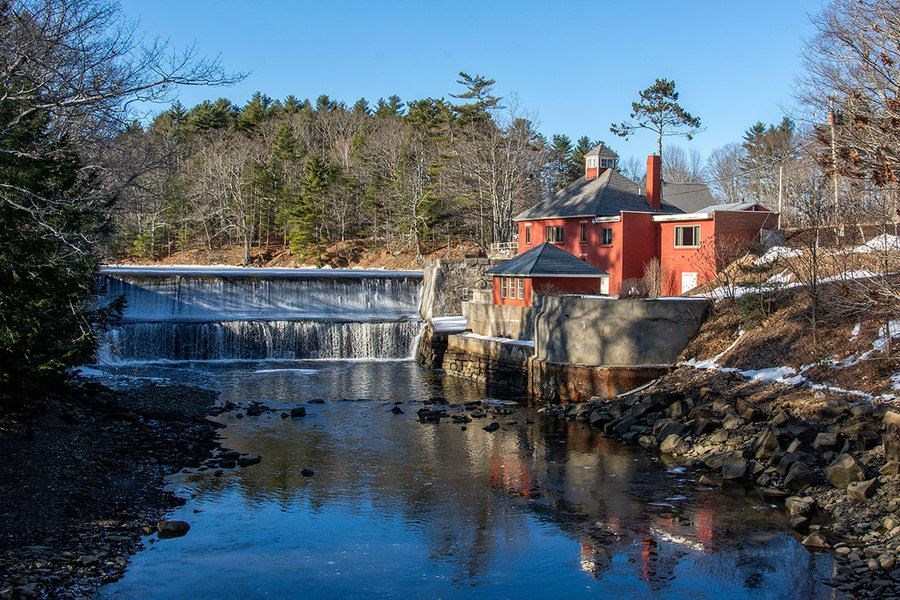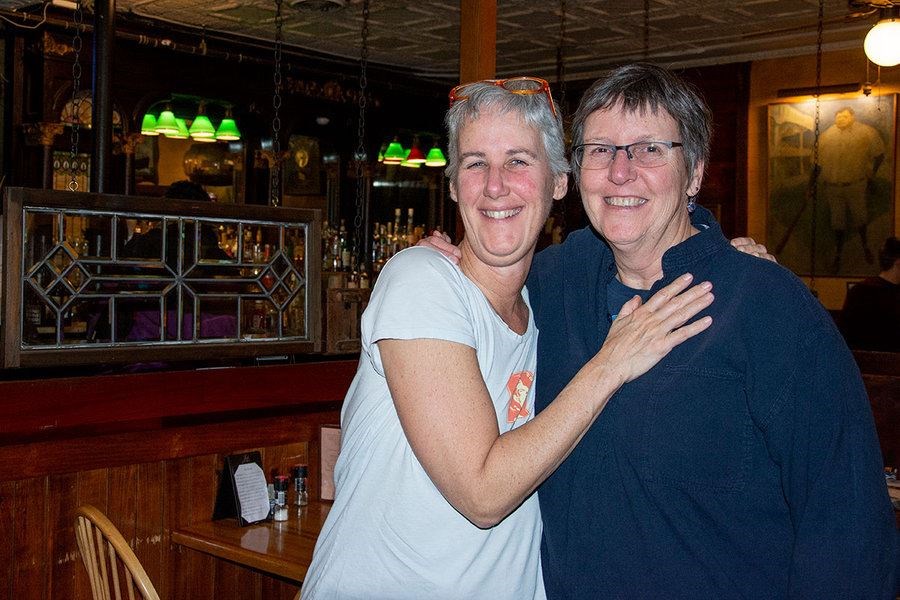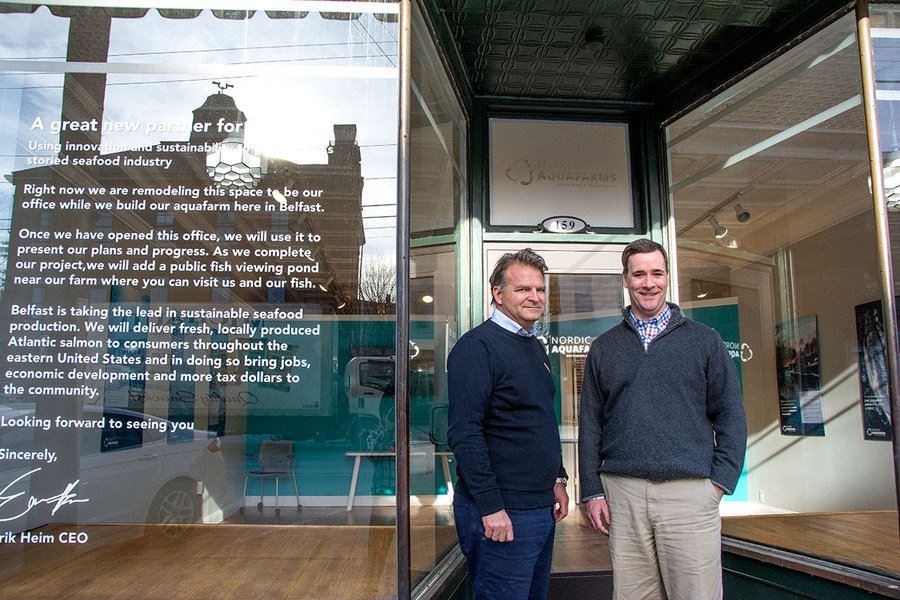Reprinted with permission from The Christian Science Monitor
Big challenges often require big solutions. But when it comes to food production, bigger isn’t always better. Can aquaculture be scaled up to feed the world without befouling the environment?
MARCH 13, 2019 - BELFAST, MAINE - Elinor Daniels loves the view from her backyard. Patches of stubborn snow dot a field ringed by pine trees. But in the next few years, this quintessential Maine landscape could be replaced by a 54-acre salmon farm.
 The Belfast Water District sits on the potential site of a land-based salmon farm being proposed by Nordic Aquafarms. If approved, the Norwegian company hopes to raise 66 million pounds of salmon annually in 18 tanks in Belfast, Maine.Story Hinckley/The Christian Science MonitorMs. Daniels and her wife have spent the past year fighting Nordic Aquafarms, a Norwegian company that aims to site one of the world’s largest land-based salmon farms in Belfast, Maine. The couple has led dozens of neighbors in a small-town battle that could have international consequences.
The Belfast Water District sits on the potential site of a land-based salmon farm being proposed by Nordic Aquafarms. If approved, the Norwegian company hopes to raise 66 million pounds of salmon annually in 18 tanks in Belfast, Maine.Story Hinckley/The Christian Science MonitorMs. Daniels and her wife have spent the past year fighting Nordic Aquafarms, a Norwegian company that aims to site one of the world’s largest land-based salmon farms in Belfast, Maine. The couple has led dozens of neighbors in a small-town battle that could have international consequences.
In the eyes of proponents, aquaculture, as the farming of fish and other water-based species is known, has a real promise to feed the world’s growing population amid depleting fisheries. To supporters of the Nordic project, the proposed Belfast farm is a model for what high-tech, environmentally savvy aquafarming can offer. But to Ms. Daniels and many of her neighbors, the kind of scale being proposed – 66 million pounds of salmon annually – reeks of big agriculture and many of the environmental problems that come with it.
“We aren’t saying ‘no’ to aquaculture,” says Ms. Daniels, as she eats dinner with her wife, Donna Broderick, at Darby’s Restaurant in downtown Belfast. “But not at this scale.”
Belfast prides itself on its slow-food, farm-to-table culture. When Ms. Daniels looks around her town, she sees the Penobscot Bay teeming with wildlife; two year-round farmers markets; dozens of small, family-owned organic farms; and a co-op – Maine’s largest – that’s busy from dawn to dusk.
At the crux of the yearlong debate in Belfast is a larger question of what the future of United States food production should look like. Both sides see Belfast, a town of fewer than 7,000, as the best example of what could be.
“People say, ‘We want to keep Belfast the way it has always been. We need more small, organic businesses,’ ” says Marianne Naess, commercial director of Nordic Aquafarms. “To feed the world we have to do things differently.”
Less than 150 years ago, the “king of fish” ran from Connecticut to northeastern Canada. In Maine’s Kennebec River alone, fishermen caught as much as 200,000 Atlantic salmon annually.
 Donna Broderick (l.) and her wife, Ellie Daniels, eat dinner at a local diner after one of their weekly Local Citizens for Smart Growth meetings on Jan. 27 in Belfast, Maine.Story Hinckley/The Christian Science MonitorToday, fewer than 1,000 wild Atlantic salmon swim in U.S. waters, with all of them living in the Gulf of Maine. U.S. populations were declared endangeredin 2000 due in part to overfishing, and populations throughout North America continue to drop. Similar stories have been playing out around the globe, as fishing pressures, pollution, and warming waters have driven fish populations down.
Donna Broderick (l.) and her wife, Ellie Daniels, eat dinner at a local diner after one of their weekly Local Citizens for Smart Growth meetings on Jan. 27 in Belfast, Maine.Story Hinckley/The Christian Science MonitorToday, fewer than 1,000 wild Atlantic salmon swim in U.S. waters, with all of them living in the Gulf of Maine. U.S. populations were declared endangeredin 2000 due in part to overfishing, and populations throughout North America continue to drop. Similar stories have been playing out around the globe, as fishing pressures, pollution, and warming waters have driven fish populations down.
Despite the global decline in fisheries, demand continues to increase. On average, people today eat more than twice as much fish as they did in the 1960s. Salmon is particularly attractive because it is one of the most efficient sources of protein available to humans – a significant concern in a world where 1 in 9 people goes hungry.
“Here is an opportunity to produce high-quality protein,” says Deborah Bouchard, director of the University of Maine’s Aquaculture Research Institute in Orono. “Land-based aquaculture is a good approach to sustainable agriculture.”
Fish farming is gaining momentum globally. Between 2000 and 2016, aquaculture almost doubled its share of food fish production. By 2030, aquaculture is expected to produce 62 percent of all food fish.
International companies such as Nordic Aquafarms see opportunity in the United States, which imports virtually all of its seafood and has been slow to develop fish farming. Despite being the third largest market in the world for seafood, the U.S. is 15th in aquaculture production.
Such operations need access to cold waters, and with Washington state – the country’s other northernmost coast – passing legislation to phase out net-pen salmon farming, companies are increasingly looking to Maine. With miles of inlet and bays, Maine has the fourth largest coastline in the country and the necessary mix of freshwater and saltwater. Maine also has an employment base that has worked in fish production for generations (albeit on the high seas) and is easily accessible to the European fish market.
“This is a really exciting time.... Maine is like a living laboratory,” says Dr. Bouchard. “We see the expansion of aquaculture in tons of different directions.”
Mid-coast Maine in particular is becoming the U.S. epicenter for aquaculture, with two of the country’s three largest land-based salmon farms being developed less than 25 miles apart.
Maine-based startup Whole Oceans is building an even bigger farm in Bucksport. As a former paper mill town, residents have largely welcomed the industry. Combined, the Bucksport and Belfast farms aim to produce almost 20 percent of the country’s salmon.
 Nordic Aquafarms president Erik Heim (l.) and project director Ed Cotter stand in front of their office in downtown Belfast on Jan. 28.Story Hinckley/The Christian Science MonitorBelfast, which used to be known as the chicken capital of Maine, has been on an economic odyssey of its own, ever since the poultry plants left in the 1980s. Nordic says the $500 million project will eventually bring about 100 jobs of various skill levels to Belfast, while supplying 7 percent of the U.S. salmon demand. But locals say the memory of the town’s agricultural past – when chicken feathers flew in the streets and chicken guts floated in the bay – has left them wary of Big Ag.
Nordic Aquafarms president Erik Heim (l.) and project director Ed Cotter stand in front of their office in downtown Belfast on Jan. 28.Story Hinckley/The Christian Science MonitorBelfast, which used to be known as the chicken capital of Maine, has been on an economic odyssey of its own, ever since the poultry plants left in the 1980s. Nordic says the $500 million project will eventually bring about 100 jobs of various skill levels to Belfast, while supplying 7 percent of the U.S. salmon demand. But locals say the memory of the town’s agricultural past – when chicken feathers flew in the streets and chicken guts floated in the bay – has left them wary of Big Ag.
“It was a mess of a town,” says Ms. Daniels. “And now we’ve been seeing aquaculture as a magic bullet.”
When Lawrence Reichard first heard about the salmon farm, he was excited.
“The idea of having Norwegians coming and floating around town, it sounded kind of fun. It sounded innovative,” says Mr. Reichard, a freelance journalist who lives in Belfast.
“I went to the first public information meeting. There were things at that meeting that didn't really add up so I started looking into it,” says Mr. Reichard. “And the more I looked into it, the more concerned I got.”
At that first public meeting in February 2018, residents quickly filled the 200 available seats and crowded the back of the room. The three subsequent informational meetings have drawn similar, if not bigger, crowds.
One of the most controversial topics at these meetings is wastewater. Opponents are concerned about the 7.7 million gallons of discharge that would flow into the Penobscot Bay daily, increasing outflows by 90 percent. Nordic has yet to receive a discharge permit from the state, an outcome opponents like Ms. Daniels are keen to prevent.
Proponents argue that the potential environmental effects of aquaculture are relatively minor when compared with those of other industries. A paper mill, for instance, would emit at least 2.5 times as much wastewater. Nordic says its discharge will undergo innovative treatment removing 99 and 85 percent of harmful, algae bloom-causing phosphorous and nitrogen, respectively.
But opponents counter that, even after filtration, discharge could significantly alter the nitrogen levels. One estimate found that the aquafarm would deposit water that is 48 to 135 times higher in nitrogen than the bay’s current level.
There’s also concern about how much water the farm will use. A recirculating aquaculture system, like the one Nordic plans to build in Belfast, requires a lot of clean water. After all, it allows fish to grow on land. Nordic plans to draw more than 400 million gallons of clean freshwater from underground aquifers per year to circulate through the farm’s 18 tanks (each one three times as large as an Olympic swimming pool).
“We don’t know how aquifers and watersheds will perform in the future with climate change,” says Mr. Reichard. “To use this much water on this scale, we’re really rolling the dice on Belfast’s water supply.”
Some locals support small-scale aquaculture, arguing that it has its own place in Belfast’s food economy.
But a recirculating system requires a big investment, says Ms. Naess, sitting at a long table in Nordic’s new Belfast office. To make it profitable, it has to be big.
“All aquaculture has its challenges,” says Ms. Naess, “but this one is the easiest to scale up around the world.”
On a January Sunday, at least two dozen Mainers in snow boots sit in a circle on fold-out chairs at the Belfast Public Library.
Attendees hail from Belfast and at least four other neighboring towns. Three people are new. State Rep. Janice Dodge holds up poster boards, teaching the attendees how to structure letters and emails to local legislators. Many people around the circle take vigorous notes.
If any good has come from the feud in Belfast, it would be a newfound interest in local government. Three Nordic opposers ran for city council seats in September, including Ms. Daniels, challenging seats that had sat unopposed for years. They have helped draft three bills for Maine’s House of Representatives to preserve the Penobscot Bay and change the permitting process for land-based aquaculture.
The opposition in Belfast has been bigger than the Nordic team expected, and the company has had to push back its original plans to break ground this spring. The company is hoping to secure the permits and applications to break ground by the end of the summer. Without any further delays, the plant expects to see its first fish leave the farm in 2022. But a lawsuit filed in July by Ms. Daniels and Ms. Broderick could further disrupt those plans. The couple is arguing that the city failed to follow its own zoning procedures when reclassifying the field behind their house as industrial.
“When you have opposers, they are loud,” says Nordic Aquafarms president Erik Heim, who is married to Ms. Naess. “There will be some people who will never agree, and we have to accept that.”
But the dozens of Mainers gathered in the library don’t show any signs of backing down. A man with a long gray ponytail, Ron Huber, tells the group he feels like the little people in the novel “Gulliver’s Travels” by Jonathan Swift, who succeed in tying down a “giant” by covering his body with many small threads.
“You think it would be impossible,” says Mr. Huber. “But they just keep throwing those small ropes.”
Page created on 3/14/2019 12:27:00 AM
Last edited 3/14/2019 12:39:09 AM
